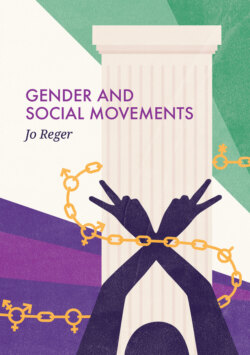Gender and Social Movements

Реклама. ООО «ЛитРес», ИНН: 7719571260.
Оглавление
Jo Reger. Gender and Social Movements
CONTENTS
Guide
Pages
Social Movements series
Gender and Social Movements
Acknowledgments
Introduction: Integrating Gender and Social Movements
How Gender “Sorts” Society
How Social Movements Change Society
How More Than Gender Matters
How Gender and Social Movements Intertwine and Influence Each Other
Integrating scholarship
Addressing inequality
Studying social change
Organization of the Book
Sources to Explore
Questions to Consider
Reflection
1 People in Movements: When Movements Focus on Single-Gender Concerns
U.S. Women’s Movements
Early movement
The “Doldrum Years”
Midcentury resurgence
Backlash in the 1980s and 1990s
Feminism in the twenty-first century
Summing up
Women’s Movements – Thinking Globally
The case of the Chilean Women’s Movement
U.S. and British Men’s Movements
Men’s rights
Pro-feminist
Studying masculinity
Men’s Movements – Thinking Globally and Intersectionally
Conclusion
Sources to Explore
Questions to Consider
Reflection
Notes
2 Gender in Movements: What Happens in Multi-Gender Movements
Womanhood, Femininity, and Movements
Women aren’t “real activists”
Women as gendered activists
Manhood, Masculinity, and Movements
“Invisible” masculinity in movements
Men as warriors
Societal Concerns and Shifting Gender Norms
Conclusion
Sources to Explore
Questions to Consider
Reflection
Notes
3 Coming to the Movement: How Gender Influences Pathways to Activism
Recruitment
Personal availability
Gendered networks
Frames and Mobilization
Gendered frames
Gendered mobilization
Movement Identities
Emotions and Movements
Doing gendered emotions
Conclusion
Sources to Explore
Questions to Consider
Reflection
Notes
4 Guiding Social Change: When Gender Shapes Movement Trajectories
Gender and Leadership
The Case of Occupy
Gendered Strategies
Gendered Tactics
Womanhood, femininity, and tactics
Manhood, masculinity, and tactics
“Hidden” Gendered Strategies and Tactics
Conclusion
Sources to Explore
Questions to Consider
Reflection
5 Legacies of Rise and Resistance: How Gender Sparks Change and Backlash
Breaking Down the Binary
Transgender and feminism
LGBTQ+ movement and transgender
Rise of the trans social justice movement
Societal Backlash and the Rise of Countermovements
Mainstream backlash
Countermovements
Intellectual and popular backlash
Conclusion
Sources to Explore
Questions to Consider
Reflection
Notes
Conclusion: Where Do We Go from Here?
Is Gender Still Relevant in Social Movements?
How Does Gender Organize Social Movements?
How are Key Aspects of Social Movements Influenced?
How Do People Respond to the Binary?
What Does the Study of Gender Bring to Social Movements (and Vice Versa)?
Notes
References
Index. A
B
C
D
E
F
G
H
I
J
K
L
M
N
O
P
Q
R
S
T
U
V
W
Y
Z
POLITY END USER LICENSE AGREEMENT
Отрывок из книги
Colin J. Beck, Radicals, Revolutionaries, and Terrorists
Amy J. Fitzgerald, Animal Advocacy and Environmentalism: Understanding and Bridging the Divide
.....
This chapter then raises the question – Why is this combination of gender and social movements important? There are three key reasons to combine the study of gender with social movements. First, the study of social movements has been slowly integrating gender scholarship, expanding our ability to see complexity of social change efforts. Understanding that gender is more than an individual quality allows for a greater grasp of inequality and efforts to address it. Second, since gender is a system of stratification, integrating it into social movements scholarship allows for new insights into the nature of inequality and social change. As we will see, gender inequality can be the start of a social movement, as well as shaping how people experience social movements. Third, as social movements seek to change society and gender norms are constantly in flux, the integration of gender and social movements captures the dynamic of how societies change over time. I address each of these – integrating scholarship, intersectionality, studying social change – in more detail.
Over three decades ago, Judith Stacey and Barrie Thorne (1985) argued that gender was the “missing revolution” in sociology. Doug McAdam (1992) echoed their call, focusing on social movements and asking scholars to consider gender as a factor in movements. Since the 1990s, social movement studies have begun to answer that call with an increase in gender scholarship, particularly focusing on women in movements. Feminist scholars argued that all social movements, regardless of whether or not they agitate for gender equality, operate within gendered institutions and settings and are engaged in the social construction of gender. This scholarly progress has come in two waves, with the first focused on understanding women’s social movement activism (Whittier 2007). However, as gender scholars expanded their research beyond the study of women, the second wave began. It was then that scholars began to consider the topic of masculinity and intersectionality in all movements.
.....